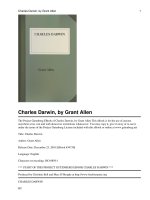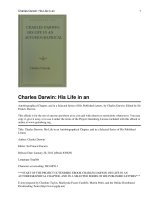Genus OpithandraB. L. Burtt and Species Opithandra DinghushanensisW. T. Wang as New Records for the Flora of Vietnam from Bac Huong Hoa Nature Reserve, Quang Tri Province
Bạn đang xem bản rút gọn của tài liệu. Xem và tải ngay bản đầy đủ của tài liệu tại đây (520.34 KB, 5 trang )
<span class='text_page_counter'>(1)</span><div class='page_container' data-page=1>
142
<i>Genus Opithandra B. L. Burtt and Species Opithandra </i>
<i>Dinghushanensis</i>
W. T. Wang as New Records for the Flora
of Vietnam from Bac Huong Hoa Nature Reserve,
Quang Tri Province
Do Thi Xuyen
1,*<sub>, Vu Xuan Phuong</sub>
2<sub>, Ha Van Hoan</sub>
3<sub>, Nguyen Anh Duc</sub>
1<sub> </sub>
<i>1</i>
<i>Faculty of Biology, VNU University of Science, 334 Nguyen Trai, Thanh Xuan, Hanoi, Vietnam </i>
<i>2</i>
<i>Institute of Ecology and Biological Resources, VAST, 18 Hoang Quoc Viet, Cau Giay, Hanoi, Vietnam </i>
<i>3</i>
<i>Bac Huong Hoa Nature Reserve, Quang Tri Province, Vietnam</i>
Received 02 May 2016
Revised 20 August 2016; Accepted 09 September 2016
<b>Abstract:</b><i> A new record of genus and species as Opithandra B. L. Burtt and species Opithandra </i>
<i>dinghushanensis</i> W. T. Wang for the flora of Vietnam. This is herb, which was called endemic of
China, but up to now we have found it in Bac Huong Hoa Nature Reserve (Quang Tri province).
Voucher specimens were deposited in the Herbarium of the Hanoi University of Scicence,
Vietnam (HNU).
<i>Keywords: Gesneriaceae, Opithandra, O. dinghushanensis, Bac Huong Hoa Nature Reserve, </i>
Quang Tri.
<b>1. Introduction*</b>
According to W. T. Wang et al. 1998 [1],
the genus <i>Opithandra</i> B. L. Burtt
(Gesneriaceae) comprises about 10 species
which mainly distributed in China, Japan,
especially eight species in China. In Vietnam,
<i>the genus Opithandra B. L. Burtt has not been </i>
recorded previously (Pellegrin, 1930; Vu Xuan
Phuong, 2005; Pham Hong Ho, 2000) [2-4].
During the field survey and based on the study
of specimen and documents of Gesneriaceae of
<i>Vietnam, we found a species of Opithandra: </i>
<i>Opithandra dinghushanensis</i> W. T. Wang in
Bac Huong Hoa Nature Reserve, Quang Tri
province, Vietnam. This is the first record of
_______
*<sub>Corresponding author. Tel.: 84-979755897 </sub>
Email:
the species as well as the respective genus in
Vietnam. Thus, to the present study,
Gesneriaceae in Vietnam are known with 31
genera. In this article, we provide
morphological characteristics of the genus
<i>Opithandra</i> B. L. Burtt and some information
<i>about Opithandra dinghushanensis in Vietnam. </i>
<b>2. Material and Methods </b>
We have examined various specimens of
<i>Opithandra </i> B. L. Burtt, including those in
</div>
<span class='text_page_counter'>(2)</span><div class='page_container' data-page=2>
Botany, China (KIB), South Botany China
Institute, China (SBCI), National Natural
Museum of History Paris, France (P), and fresh
specimens collected in recent field survey.
The comparative morphology method was
used for study. This is the standard method for
classification of plants, based on the
morphological characteristics of the external
organs, especially the reproductive organs,
because the reproductive characteristics are
closely related to the genetic code and little
altered by the impact of the environment.
<b>3. Results </b>
<i>3.1. The main morphological characteristics of </i>
<i>the genus Opithandra B. L. Burtt </i>
<i>OPITHANDRA</i> B. L. Burtt - Ô PI
B. L. Burtt 1956. Baileya. 4: 162; Pan K. Y.
in W. T. Wang, K. Y. Pan & Z. Y. Li, 1990. Fl.
Reipub. Pop. Sin. 69: 260 [5]; Wang W. T. et
al. 1998. Fl. China, 18: 289. [1]
<i>- SCHISTOLOBOS W. T. Wang. 1983. Bot. </i>
Res. Academia Sinica 1: 15. [6]
Herbs, perennial, epipetric or terrestrial,
rhizomatous, stemless. Leaves few to many,
basal. Inflorescences often umbel-like, axillary,
1- to many-flowered cymes; bracts 2, opposite.
Calyx actinomorphic, 5-sect from base to
deeply 5-lobed; segments equal. Corolla violet,
zygomorphic; tube tubular to funnelform, or
cylindric, much longer than limb; 2-lipped;
adaxial lip 2-lobed, usually distinctly shorter
than, rarely nearly as long as abaxial lip;
abaxial lip 3-lobed. Stamens 2, adnate to corolla
tube near middle, included; anthers basifixed,
free or coherent at apex, thecae parallel, not
confluent; connective not projecting;
staminodes 2. Ovary linear, 1-loculed, longer
than calyx; capsule straight in relation to
pedicel, linear, dehiscing loculicidally to base;
valves 2, straight, not twisted. Seeds
unappendaged.
<b>Typus:</b> Opithandra primuloides (Miq.) B.L.
Burtt [Boea primuloides Miq.] [7, 8].
There are ten species in the world, mostly in
China, Japan. To the present study, one species
is found in Vietnam.
<i>The genus Opithandra has leaves whorled; </i>
base asymmetric; inflorescences umbelllike;
ovary linear, longer than calyx, corolla
zygomorphic, stament 2, staminodes 2, seeds
<i>without appendages so that Opithandra in Trib. </i>
<b>2. Didymocarpeae with 19 other genus as </b>
<i>Petrocosmea, </i> <i>Hemiboea, </i> <i>Henckelia, </i>
<i>Microchirita, </i> <i>Primulina, </i> <i>Lagarosolen, </i>
<i>Pseudochirita, Calcareoboea, Didymocarpus, </i>
<i>Gyrocheilos, </i> <i><b>Paraboea, </b></i> <i>Boea, </i> <i>Boeica, </i>
<i>Oreocharis, </i> <i>Briggsia, </i> <i>Raphiocarpus, </i>
<i>Cathayanthe, Baccarinda, Ornithoboea</i>.
<i>The genus Opithandra is the closest to </i>
<i>Pseudochirita</i> but differs with leaf few to many,
basal; calyx 5-sect from base to deeply 5-lobed;
<i>and Pseudochirita has</i> leaf opposite; calyx
connate to cup or campanulate, 5-lobed.
<i>3.2. Key to the genera of Didymocarpeae of Vietnam </i>
1A. Stament 4, free or coherent couple or coherent 4 at the anther; staminodes 1.
2A. Stament 4, free; staminodes 1.
3A. Leaves opposite or near alternate; corolla 2 lipped (2/3); adaxial lip 2 lobed, abaxial lip 3 lobed;
<i>tube distend at the base. (with hunch) ... 1. Boeica </i>
3B. Leaves basal; corolla 2 lipped (2/3); tube non distend at the base. (without hunch). ...
<i> ... 2. Oreocharis </i>
2B. Stament 4, coherent couple or coherent 4 at the anther.
</div>
<span class='text_page_counter'>(3)</span><div class='page_container' data-page=3>
5A. Stigma conspicuously 2 lobed.
<i>6A. Leaves basal. Inflorescences umbelike; corolla tube distend at the base. ...3. Briggsia </i>
6B. Leaves alternate along the stems, asymmetric in the couple. Inflorescences cymes; corolla funnel,
<i><b>tube non distend at the base. ... 4. Raphiocarpus </b></i>
<i><b>5B. Stigma near entire, oblique undulate. ... 5. Cathayanthe </b></i>
<i><b>4B. Stament 4, coherent 4 at the anther. Leaves basal. ... 6. Beccarinda </b></i>
1B. Stament 2, free or coherent 4 at the anther; staminodes 3.
7A. Fruit capsular, not twisted.
8A. Bracts large into globose enclose at the base; fruit oblique in relation to pedicel...…………
<i>...7. Hemiboea </i>
8B. Bracts small, opposite, not into globose enclose at the base; fruit straight in relation to pedicel.
9A. Ovary globose or broadly ovoid ; fillament adnate corolla tube near base; stament coherent or
<i>non coherent; corolla tube as long as limb...8. Petrocosmea </i>
9B. Ovary cylindric or linear; fillament adnate at middle or toward to the top of the orcorolla tube;
stament coherent; corolla tube longer limb.
10A. Stigma usually with 2 lobed.
11A. Anther dorsifixed; disc ring; capsular dehiscens by 2 or 4 valves.
12A. Inflorescences umbelike; corolla lobed round or obtuse; rarely abaxial lip as twice adaxial lip
<i><b>13A. Sepal connate at the base, sepal lobes without upto base... 9. Henckelia </b></i>
<b>13b. Sepal not connate at the base, sepal lobes upto base </b>
14A. Plant usually stemless and leaves basal or plant with stem and leaves on the top. ...
<i>………..10. Primulina </i>
<i><b>14B. Plant usually stem and leaves opposite along the stem. ... 11. Microchirita </b></i>
12B. Inflorescences cymces; corolla lobed acute; abaxial lip as twice adaxial lip. ...
<i> ... 12. Lagarosolen </i>
11B. Anther balsifixed; disc cup; capsular dehiscens by 2 valves.
<i>15A. Leaf opposite; calyx connate to cup or campanulate, 5-lobed... 13. Pseudochirita </i>
<i>15B. Leaf few to many, basal; calyx 5-sect from base to deeply 5-lobed...14. Opithandra </i>
10B. Stigma 1.
16A. Adaxial lip 2 or 4 lobed.
17A. Corolla 2 lipped (4/1), adaxial 4 lobed, abaxial 1 lobed; bracts into globose enclose at the base….
<i>……14. Calcareoboea </i>
<i>17B. Corolla 2 lipped (2/2), adaxial 2 lobed, abaxial 3 lobed; bracts 2, opposite... 15. Didymocarpus </i>
<i>16B. Adaxial lip 1, abaxial 3 lobed.. ... 16. Gyrocheilos </i>
7B. Fruit capsular, usually twisted.
18A. Adaxial lip near as long as abaxial lip; inner abaxial lip without hair.
</div>
<span class='text_page_counter'>(4)</span><div class='page_container' data-page=4>
<i>3.3. </i> <i>Some </i> <i>information </i> <i>on </i> <i>Opithandra </i>
<i>dinghushanensis W. T. Wang, a new record for </i>
<i>the flora of Vietnam </i>
<i>Opithandra dinghushanensis</i> W. T. Wang -
Ơ pi quảng đơng
W. T. Wang, 1987. Bull. Bot. Res. Harbin,
7(2): 10, pl. 4, f. 1–5; Pan K. Y. in W. T. Wang,
K. Y. Pan & Z. Y. Li, 1990. Fl. Reipub. Pop.
Sin. 69: 265 [5]; Wang W. T. et al. 1998. Fl.
China, 18: 296 [1]; Wei J. G., 2010. Gesn. S.
<b>China, 647 [9]. </b>
Herbs, perennial, epipetric or terrestrial,
rhizomatous, stemless. Leaves few to many,
basal; petiole 2-4(7) cm, densely grayish
strigose, puberulent to woolly or velutinous;
leaf blade narrowly elliptic to elliptic-ovate, 4-9
x 3-5 cm, herbaceous, nearly flat, short strigose,
base oblique, broadly cuneate to cordate,
margin nearly entire to indistinctly repand, apex
acute; lateral veins ca. 5-7(8) on each side of
midrib. Inflorescences often umbel-like,
axillary, 1- to many-flowered cymes, mainly as
1-2 flowered cymes in the plant; peduncle ca.
5-7 cm, short strigose and tomentosa; bracts 2,
opposite, linear, small. Calyx 5-sect from base;
segments lanceolate to narrow elliptic, 2-2.5 x
0.8-10 mm, apex caudate-acuminate, tip
somewhat obtuse or cunnate. Corolla violet, ca.
2.7-3,3 cm, glabrous, margin sparsely ciliate;
tube funnelform, not swollen; corolla tube
much longer limb; adaxial lip ca. 4-5 mm;
abaxial lip ca. 7-8.5 mm, lobes entire; apex
rounded. Stamens adnate to corolla tube near
middle, ca. 1-1.2 cm; filaments sparsely
puberulent; anthers coherent at apex,
globose-ovoid, dehiscing from arcuate slits; staminodes
2, abaxial, ca. 1-1.5 mm, very small; disc cup
but inconspicuous. Pistil included, ca. 1.5-1.7
cm; ovary puberulent. Style ca. 3-5 mm,
glandular puberulent; stigmas 2; young fruit
linear, fruit straight in relation to pedicel; seeds
unappendaged.
<i><b>Loc. class.:</b></i> China, Guangdong, Zhaoqing,
<i><b>Dinghushan, Tielukeng. Typus: G.L. Shi 12470 </b></i>
(SCBI).
<i><b>Ecology:</b></i> Flower and young fruit in
August-October. In every green forest, soil mountains
and limestone mountains, mainly on the rocks
in valley forests, moist places, mainly at
800-1100 m about the sea.
<i><b>Distribution: </b></i>Quang Tri (Bac Huong Hoa
Nature Reserve: Voi Mep). [China
(Guangdong: Dinghushan, Gaoyao Xian)].
<i><b>Specimen:</b></i> QUANG TRI, D.T. Xuyen,
D.M. Tu, T.A. Duc, H.V. Hoan, N.T. Hieu,
N.T. Hung, N.T. Huy, T.V. Hiep, BHH-XTD
519 A, B (HNU); at 160<sub>45’08.7 N; 106</sub>0<sub>40’41.3 </sub>
E; at 1003 m; date August 16th<sub>2014, sub-area </sub>
670A.
G
<b>Fig. 1. Opithandra dinghushanensis W. T. Wang. </b>
1. plant with flower; 2. sepal opened; 3. corolla
opened with stamen and style; 4. anther
(Specimen BHH-XTD 519 A, HNU;
painter V. X. Phuong)
<b>Acknowledgments</b>
This study was supported by VNU Asia
Research Center, under the research grant
<i>CA15.11A</i>. The authors would like to thank this
</div>
<span class='text_page_counter'>(5)</span><div class='page_container' data-page=5>
P, VNM. We thank Bắc Hướng Hóa Nature
Reserve, Quang Tri and others for providing
some materials and creating opportunity for us
studying this.
<b>References </b>
[1] Wang W. T. et al., Flora of China, 18: 245-401.
USA, 1998.
[2] Pellegrin F. in H. Lecomte, Flore générale de
L’Indo-chine, 4: 487-565, Paris, 1930.
[3] Vu Xuan Phuong, Checklist of Plant species in
Vietnam, 3: 272-274, 2005.
[4] Phạm Hoang Ho, An Illustrated flora of
Vietnam, 3: 12-29, Tre publishing house, Ho
Chi Minh city, 2000
[5] Pan K. Y. in W. T. Wang, K. Y. Pan & Z. Y. Li,
Flora Reipublicae Popularis sinicae, 69: 125-
581. Science Press, Beijng, 1990.
[6] Backer C. A. & C. R. Bakhuizen, Flora of Java,
2: 518-534. Netherlands, 1965.
[7] Burtt B. L., Notes Roy, Bot. Gard. Edinburgh,
36 (1), (1977) 151-155.
[8] Davidson R. & B. L. Burtt, Notes Roy, Bot.
Gard. Edinburgh, 21(4) (1954), 193-208.
[9] Wei J. G., Gesneriaceae of South China, 778 pp.
Giangxi Science and Technology Publishing
House, 2010.
<i>Chi Ô pi (Opithandra B. L. Burtt) và loài Ô pi quảng đơng </i>
<i>(Opithandra dinghushanensis W. T. Wang) chi và lồi </i>
bổ sung cho hệ thực vật Việt Nam từ Khu bảo tồn thiên nhiên
<b>Bắc Hướng Hóa, tỉnh Quảng Trị </b>
Đỗ Thị Xuyến
1, Vũ Xuân Phương
2, Hà Văn Hoan
3, Nguyễn Anh Đức
1<i>1</i>
<i>Khoa Sinh học, Trường Đại học Khoa học Tự nhiên, ĐHQGHN, </i>
<i>334 Nguyễn Trãi, Thanh Xuân, Hà Nội, Việt Nam </i>
<i>2</i>
<i>Viện Sinh thái và Tài nguyên sinh vật, VAST, 18 Hoàng Quốc Việt, Cầu Giấy, Hà Nội, Việt Nam </i>
<i>3</i>
<i><b>Khu BTTN Bắc Hướng Hóa, tỉnh Quảng Trị, Việt Nam </b></i>
<b>Tóm tắt: </b><i>Ghi nhận chi Opithandra với loài Opithandra dinghushanensis W. T. Wang. - Ơ pi </i>
quảng đơng cho hệ thực vật Việt Nam. Đây là loài cây thảo, trước kia được coi là đặc hữu của Trung
Quốc, hiện chúng tơi đã tìm thấy có ở Khu BTTN Bắc Hướng Hóa (Quảng Trị). Mẫu vật hiện đang
được lưu giữ tại Phòng tiêu bản thực vật của Trường Đại học Khoa học Tự nhiên (HNU).
</div>
<!--links-->









